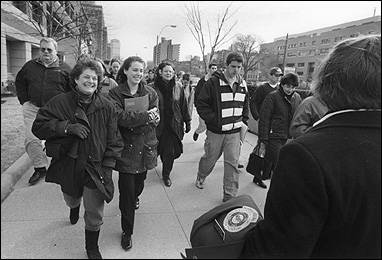![]()
Departments
![]()

|
Week of 26 February 1999 |
Vol. II, No. 25 |
Feature
Article
Class of 2003 applicants raise bar on quality and diversity
By Hope Green
Never mind Horace Greeley's advice. For many youths of Phoenix and Fargo, it appears that "Go East" is the new rallying cry. Preliminary data gathered by the Office of Admissions suggest that the Class of 2003 applicant pool includes historically high numbers of students hailing from states west of the Mississippi and south of the Mason-Dixon Line.
Overall, a record 28,000 high school students from around the world applied to BU by the January 15 deadline, topping last year's figure by 8.8 percent. Applications are still being processed, but judging by the rough data, Admissions Director Thomas Rajala foresees another academically talented group of freshmen arriving on campus in September. Admitted students in the Class of 2002, including all of the University's undergraduate programs, averaged 1263 points on the SAT I, and ranked in the top 13 percent of their high school classes. According to Rajala, a year-by-year comparison of applicant-pool SAT scores indicates that the Class of 2003 will up the ante.
|
|
|
Potential members of BU Class of 2003 (below) and their parents on a recent guided tour of the BU campus. Photo by Kalman Zabarsky |
"We might all have a McDonald's and a Dunkin' Donuts," Rajala says, "but we also have some pretty sharp cultural distinctions in New England compared with the rest of the country. There are built-in educational benefits to having as many different approaches to life and culture on one campus as possible."
To an increasing extent, the admissions director notes, teenagers are shopping for colleges on the Web. BU offers an online campus tour along with a link to its electronic application form, which is also available on CD-ROM. Almost a fifth of the applications the University received this year were submitted electronically, as compared with 11 percent last year.
The Admissions Office had attempted to limit the applicant pool to 24,000, while setting 4,080 as the target number for freshmen in the Class of 2003. "Last year," Rajala says, "the ratio of students who decided to enroll at BU after being accepted went up by more than two points in CAS, giving us 200 more freshmen than we had planned for. It was what some would call a pleasant surprise, because it sends a good message to the world about the University.
"At the same time, it brings housing crunches and quality of life concerns that create stress points around the campus. So we're going to work really hard this year at doing our best prediction job ever. We want to get as close to that 4,080 target as we possibly can."
